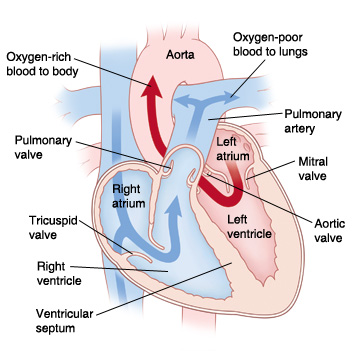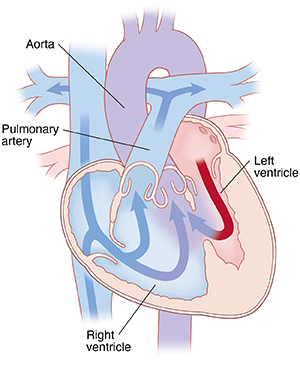Double Outlet Right Ventricle
Double outlet right ventricle (DORV) is a rare heart malformation. It’s when the heart and the main vessels leaving the heart don’t develop the way they should. The problem is present from birth (congenital).
In a normal heart, the blood flows:
-
From veins returning from the body into the right atrium
-
From the right atrium through the tricuspid valve into the right ventricle
-
From the right ventricle through the pulmonary valve into the pulmonary artery to the lungs
-
From the lungs through the pulmonary veins into the left atrium
-
From the left atrium through the mitral valve into the left ventricle
-
From the left ventricle through the aorta valve into the aorta to the rest of the body
A wall (atrial septum) between the heart’s upper and lower chambers stops blood from flowing between the left and the right sides of the heart. A series of heart valves prevent the blood from going backward in the flow.
In a child with DORV, both the pulmonary artery and the aorta are connected to the same chamber, the right ventricle. There is also almost always an opening in the wall between the left and right ventricles. This hole is called a ventricular septal defect (VSD).
This VSD lets blood with oxygen mix with blood that has little oxygen. A child with DORV is not able to get enough oxygen-rich blood to the rest of the body.
Much of the time, DORV occurs with other heart malformations.
 |
| Normal heart. |
 |
| Heart with DORV. |
What causes DORV?
DORV is rare. Healthcare providers don’t know exactly what causes it. Sometimes DORV is caused by problems with a child’s genes. It is linked to a number of genetic syndromes. Two of these are trisomy 13 and Robinow syndrome. But in most cases, the cause of DORV is unknown.
Some things in the environment can lead to a heart defect if a mother is exposed to them when she is pregnant. Mothers may be able to lower their child’s risk for DORV by avoiding:
-
Radiation from dental or medical procedures
-
Tobacco and alcohol
-
Exposure to infections
-
Certain medicines, such as those used for asthma, depression, seizures, diabetes, or skin problems
-
Dietary deficiencies such as folic acid
Symptoms of DORV
The symptoms of DORV may vary based on the exact heart problem involved. Symptoms are often present at birth. They can include:
-
Bluish color (cyanosis) of the skin, lips, or nails, or pale skin
-
Fast breathing or problems breathing
-
Tiring easily, especially when feeding
-
Failure to gain weight normally
-
Swelling in the legs or belly (abdomen)
-
Sleepiness or unresponsiveness
Diagnosing DORV
Healthcare providers may spot DORV in a developing baby, before birth, through a fetal echocardiogram. After a baby is born, diagnosis starts with a health history and physical exam. Certain tests can also help. These include:
-
Echocardiogram to see the structure of the heart and the blood flow through the heart
-
Electrocardiogram to study the heart’s rhythm
-
Chest X-ray to look at the size of the heart and lungs
-
Cardiac MRI to look at the structure of the heart
-
Cardiac catheterization to learn more about the pressures in the different chambers of the heart and in the lungs (using dye can help show blood flow through the heart)
-
Blood tests to look for oxygen levels in the blood
Treatment for DORV
Surgery is the typical treatment for DORV. A surgeon can fix blood flow so that it moves the correct way from the left ventricle to the aorta and from the right ventricle to the pulmonary artery. Your child may need more than one surgery. DORV can range from simple to complex. Not all children with DORV are treated with the same surgery. Depending on the complexity of your child's DORV, your child may need more than one surgery or procedure. That's because a child can have more than one congenital defect that needs to be fixed. Early treatment can lower the chance of later problems, such as heart failure and infection of the heart valves.
Some children with DORV also need medicine. The kind of medicine depends on the type of DORV and how serious the symptoms are. Medicine may include:
-
Water pills (diuretics) to reduce swelling
-
ACE inhibitors or digoxin to make it easier for the heart to pump blood to the rest of the body
-
Beta-blockers to reduce how hard the heart pumps
-
Blood thinners (anticoagulants) to prevent blood clots
-
Antibiotics before certain medical and dental procedures to prevent infection
Most children with DORV go on to lead normal and active lives. But they will need to see a heart specialist regularly. Some may need more surgery as adults.
When to call the healthcare provider
You will be told how to care for your child and about medicines your child needs. Be alert for any changes in your child's behavior or increased symptoms. These could be a warning for something else.
Call your child’s healthcare provider right away, or seek immediate care, if your child has a hard time breathing, trouble feeding, weight loss, swelling (edema), extreme tiredness (fatigue), or other severe symptoms.